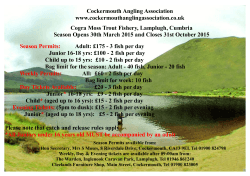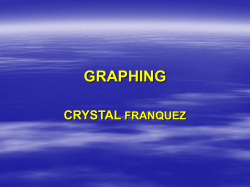
Substances of emerging concern â evaluating effects
Substances of emerging concern – evaluating effects Karen Kidd, University of New Brunswick, Saint John, NB cleaning products cosmetics pain killers antimicrobials hormones nanomaterials etc., etc. • Municipal wastewaters complex mixture of chemicals • Natural and synthetic estrogens linked to feminization of male fishes Feminized male fish have: • Smaller gonads • Vitellogenin • Intersex Implications for sustainability of fishes? (#1 - whole ecosystem experiment) Eggs in testes – wow! Darter, Grand River, ON Bahamonde, Servos Implications for fish populations and aquatic food webs? Experimental Lakes Area (IISD-ELA) Lake 260 - Estrogen Addition Lake 2 years baseline 3 summers of additions (5-6 ng/L) 17a-ethynylestradiol (EE2) EE2 additions caused: - High vitellogenin production in males - Delayed sperm cells - Population impacts? Max depth – 14 m Surface area – 36 ha 7 years recovery Spring catches 1000 Fathead minnow - YOY 100 CPUE EE2 additions led to near extinction of fathead minnow population 10 99% 1 0.1 Lake 260 Reference 0.01 1998 2000 Collapse of fathead minnow – Kidd et al. 2007 PNAS Recovery of fathead minnow – Blanchfield et al. 2015 Environ. Sci. Technol. Food web implications – Kidd et al. 2014 Phil. Trans. Royal Soc. B Funding: CWN, NSERC, Fisheries and Oceans, ACC, Bayer Schering Pharma AG +EE2 2002 2004 2006 What did we learn from this study? 4. Whole lake experiments invaluable 3. Indirect effects on fish prey 1. Direct effects on fish populations 2. Indirect effects on fish predators What tools best identify impacts of substances of emerging concern? A national CWN study • Municipal wastewater treatment plants unique personalities, treatments, receiving environments • How do we assess impacts? Expert workshop held • #2 - CWN project (2013) to develop toolbox to identify sites of higher and lower concern (ending spring 2015) Small river receiving wastewaters after advanced treatment? Large river receiving wastewaters after secondary treatment? What measures best assess effects on fish? Saskatchewan River (M. Hecker and colleagues, University of Saskatchewan) St. Lawrence River Wascana Creek, SK (M. Fournier, F. Gagné and colleagues, Université du Québec & Environment Canada) Grand River, ON (M. Servos and colleagues University of Waterloo) www.dcnature.com/photos/index.cfm?photoID=138 infotrek.er.usgs.gov/wdnr_fishes/ www.fpc.org/bon_jda/juvnonsalmon.html en.wikipedia.org/wiki/Greenside_darter - Multidisciplinary, collaborative approach - Comparisons across diverse sites and diverse species What is being evaluated? Influents and effluents Measures 1) Chemistry 2) In vitro bioassays 3) In vivo bioassays Wild fish Measures 1) Whole organism 2) Tissue 3) Physiological 4) Exposure Which tools are most effective? Links across levels of biological organization Summary and value of toolbox approach – opportunities and value • Results being contrasted across sites • Identifying endpoints that distinguish sites of high and low concern • Engaged in similar WERF Phase 2 project in US • Near future - Develop guide for managers/operators, validate toolbox at other sites • Common approach to assess: • whether there is a concern, where it is greatest • effectiveness of changes in treatment • Informs decisions, focuses resources kiddk@unb.ca
© Copyright 2025















